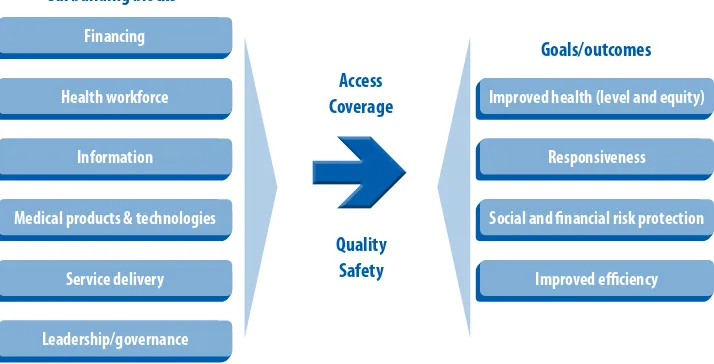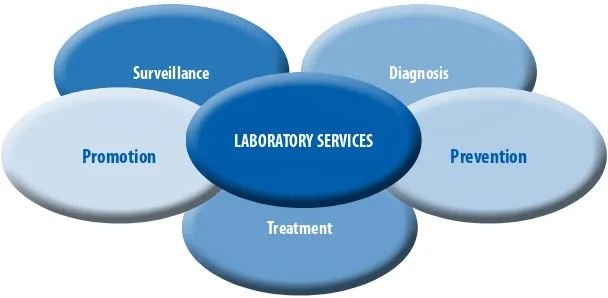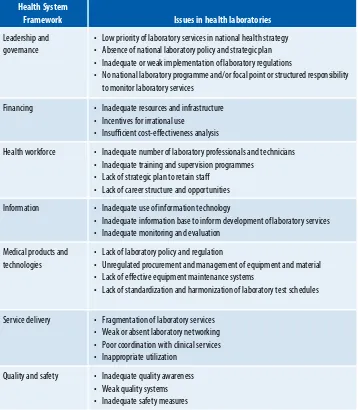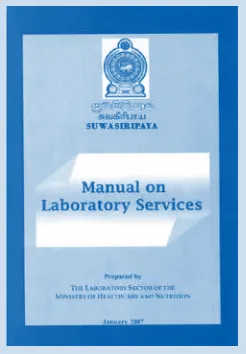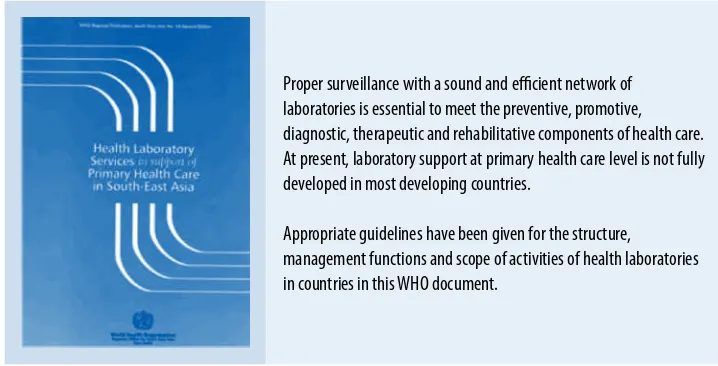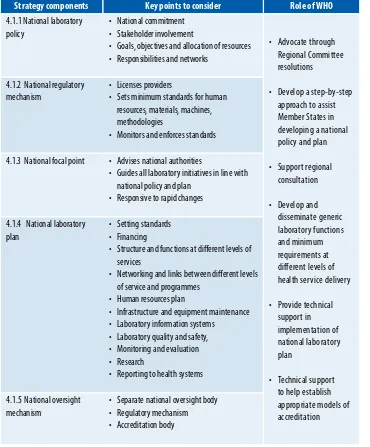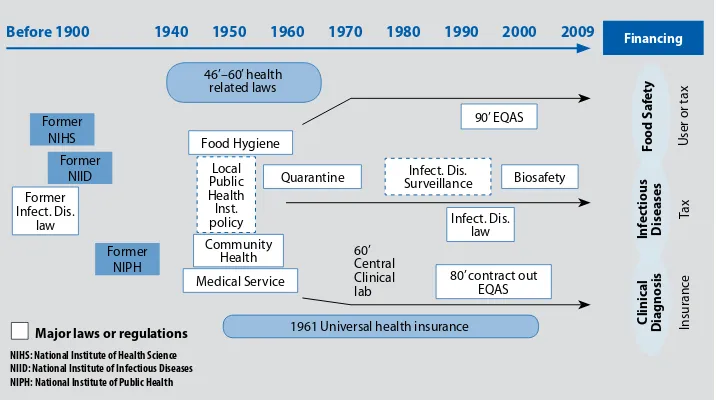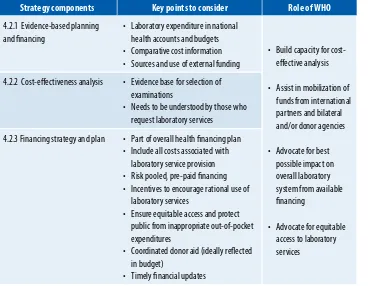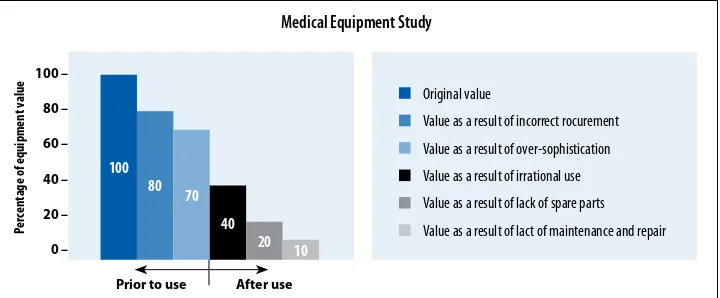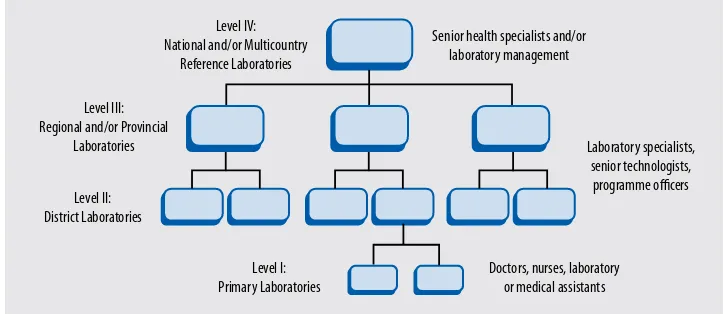Asia Paciic Strategy
for Strengthening
WHO Library Cataloguing in Publication Data
Asia Paciic strategy for strengthening health laboratory services.
1. Laboratories – standards. 2. Laboratory techniques and procedures – standards. 3. Quality control. 4. Asia, Southeastern. 5. Western Paciic.
I.World Health Organization. Regional Oice for South-East Asia.
II.World Health Organization. Regional O ffice for the Western Pacific.
ISBN 978 92 9061 429 6 (NLM Classiication: WA 23 )
© World Health Organization 2010
All rights reserved. Publications of the World Health Organization can be obtained from WHO Press, World Health Organization, 20 Avenue Appia, 1211 Geneva 27, Switzerland (tel.: +41 22 791 3264; fax: +41 22 791 4857; e-mail: bookorders@who.int). Requests for permission to reproduce or translate WHO publications – whether for sale or for noncommercial distribution – should be addressed to WHO Press, at the above address (fax: +41 22 791 4806; e-mail: permissions@ who.int). For WHO Western Paciic Regional Publications, request for permission to reproduce should be addressed to the Publications Oice, World Health Organization, Regional Oice for the Western Pacific, P.O. Box 2932, 1000, Manila, Philippines, Fax. No. (632) 521-1036, email: publications@wpro.who.int
The designations employed and the presentation of the material in this publication do not imply the expression of any opinion whatsoever on the part of the World Health Organization concerning the legal status of any country, territory, city or area or of its authorities, or concerning the delimitation of its frontiers or boundaries. Dotted lines on maps represent approximate border lines for which there may not yet be full agreement.
The mention of speciic companies or of certain manufacturers’ products does not imply that they are endorsed or recommended by the World Health Organization in preference to others of a similar nature that are not mentioned. Errors and omissions excepted, the names of proprietary products are distinguished by initial capital letters.
PREFACE . . . .
viiEXECUTIVE SUMMARY . . . .
ix1. Introduction . . . .
12. Background . . . .
32.1 Health systems strengthening and laboratory services . . . .3
2.2 Overview of laboratory services in the Asia Paciic Region . . . .5
3. Objectives . . . .
84. Key strategic elements for health laboratory services . . . .
84.1 Establish a coherent national framework for laboratory services . . . .8
4.1.1 National laboratory policy . . . .9
4.1.2 National regulatory mechanisms . . . .11
4.1.3 National focal point . . . .12
4.1.4 National laboratory plan . . . .12
4.1.5 National oversight mechanism . . . .15
4.2 Finance laboratory services in a sustainable manner . . . .17
4.2.1 Evidence-based planning and inancing . . . .17
4.2.2 Capacity for cost-efectiveness analysis . . . .17
4.2.3 Financing strategy and plan . . . .18
4.3 Build capacity for laboratory services . . . .20
4.3.1 Physical infrastructure and equipment . . . .21
4.3.2 Human resources . . . .22
4.3.3 Procurement and supply management . . . .24
4.3.4 Laboratory networks . . . .24
4.3.5 Transportation of specimens . . . .26
4.3.6 Information systems and communication . . . .27
Asia Paciic Strategy for Strengthening Health Laboratory Services (2010-2015)
4.4 Assure the quality of health laboratory services . . . .30
4.4.1 Management commitment and quality policy . . . .31
4.4.2 Quality standards . . . .31
4.4.3 Training of human resources . . . .32
4.4.4 Documentation and its control . . . .33
4.4.5 Assessment . . . .33
4.4.6 Development of a quality system . . . .34
4.5 Promote the rational use of laboratory services . . . .36
4.5.1 Health service providers . . . .36
4.5.2 Appropriate development of laboratory services . . . .37
4.5.3 Community awareness . . . .38
4.6 Improve laboratory safety . . . .39
4.6.1 Biosafety . . . .40
4.6.2 Biosecurity . . . .41
4.6.3 Occupational health and safety . . . .42
4.6.4 Waste management including environmental protection . . . .42
4.7 Support research and ethics in laboratory settings . . . .44
4.7.1 Operational research . . . .44
4.7.2 Appropriate technology . . . .44
4.7.3 Developing new methods and tools . . . .45
4.7.4 Research ethics . . . .46
THE WAY FORWARD . . . .
47INDICATORS . . . .
50Examples of country indicators . . . .50
Proposed regional indicators . . . .51
Glossary . . . .
53Asia Paciic Strategy for Strengthening Health Laboratory Services
(2010-2015)
Figures
Figure 1: The WHO Health System Framework . . . 4
Figure 2: Role of Laboratory Services . . . 6
Figure 3: Sri Lanka adopts National Laboratory Policy and Manual on Laboratory Services . . . 11
Figure 4. Health Laboratory Services in support of Primary Health Care in South-East Asia . . . 15
Figure 5: Trends of health policy related to laboratory . . . 19
Figure 6: Health technology assessment and utilization of resources . . . 22
Figure 7: The tiered, integrated laboratory network . . . 25
Figure 8: Quality Standards in Health Laboratories in Thailand . . . 32
Figure 9: Development of a quality system . . . 35
Figure 10: Essential controls of biosafety . . . 41
Tables
Table 1: Major issues in health laboratories in the Asia Paciic region . . . 7Table 2: Strategic element: A coherent national framework for laboratory services . . . 16
Table 3: Strategic element: Finance laboratory services in a sustainable manner . . . 20
Table 4: Strategic element: Build capacity for laboratory services . . . 29
Table 5: Strategic element: Assure the quality of laboratory services . . . 35
Table 6: Strategic element: Promote the rational use of laboratory services . . . 39
Table 7: Strategic element: Improve laboratory safety . . . 43
PREFACE
Health laboratory services are an integral component of the health system. Efficiency and effectiveness of both clinical and public health functions including surveillance, diagnosis, prevention, treatment, research and health promotion are inluenced by reliable laboratory services. Despite this central role, strengthening nationally coordinated laboratory services has, until recently, received little or inadequate attention in many countries. This has resulted in laboratory services having very low national priority in respect to inancing, planning and service delivery.
Given the growing importance of health laboratories and emphasis on evidence-based medical and public health practices, it is imperative that health laboratories are strengthened to provide critical inputs in making informed decisions.
This biregional strategy addresses policy and technical issues for strengthening health laboratory services. It calls for each Member State to develop a national laboratory policy and strategic plan, and emphasizes various components that are critical for providing appropriate infrastructure, expertise, quality, safety and technologies to assure eicient laboratory support.
Asia Paciic Strategy for Strengthening Health Laboratory Services (2010-2015)
WHO is committed to providing normative and technical support to all its Member States in implementation of this strategy and strengthening of health systems.
Samlee Plianbangchang, M.D., Dr.PH. Shin Young-soo, M.D., Ph.D.
Regional Director Regional Director
EXECUTIVE SUMMARY
Eicient and reliable health laboratory services are an essential and fundamental component of any strong and efective health system and its goal to improve health. Reliable and timely results from laboratory investigations are crucial in decision-making in almost all aspects of health services.
While considerable efort has gone into improving health laboratory services in the Asia Pacific Region, much of the focus has been on specific disease control programmes such as polio, measles, HIV/AIDS, tuberculosis (TB) and malaria. As a result, laboratory services are often fragmented and other parts of the laboratory system are accorded low priority with inadequate allocation of resources. There is often no national laboratory policy or strategic plan to deliver comprehensive and integrated quality laboratory services to all those who need them.
The Asia Paciic Strategy for Strengthening Health Laboratory Services (2010– 2015) presents a brief overview of the major challenges in assuring reliable laboratory services and offers a health systems perspective in dealing with them. The objective of this strategy is to assist Member States in providing comprehensive laboratory services to contribute to improved health outcomes in the Asia Paciic Region. In acknowledging that “one size does not it all”, it suggests an approach that national authorities can adapt to their country or regional contexts and integrate with their existing national health policies, strategies and resources.
Asia Paciic Strategy for Strengthening Health Laboratory Services (2010-2015)
The strategy articulates the need for sufficient resources and appropriate inancing mechanisms to promote rational use of services and avoid conlicts of interest. It proposes using cost-efectiveness tools, de-linking provider income from tests requests and moving toward prepaid pooled funding mechanisms rather than user-fees.
The strategy emphasizes building capacity for laboratory services including design of a tiered laboratory network with each level having appropriate physical infrastructure, human resources, procurement and supply management, referral networks and information system. It promotes quality, biosafety, occupational health, and rational use of laboratory services and operational research to assure use of appropriate technology.
1. Introduction
Progress towards achieving the Millennium Development Goals (MDG) to reduce morbidity and mortality related to HIV/AIDS, malaria and other major diseases has been slow, partly because of the lack of access to quality medicines and health technologies, in particular diagnostics and laboratory services.
Laboratories are an essential and fundamental part of all health systems and their goal to improve health. Reliable and timely results from laboratory investigations are crucial elements in decision-making in almost all aspects of health services. Critical decisions dependent on laboratory results concern health security, national economies and meeting obligations such as the International Health Regulations (IHR) as well as the health and well-being of individuals.
The spectrum of laboratory investigations ranges from sophisticated and expensive to simple, familiar and inexpensive. Overall, medicines, vaccines and health technologies consume approximately 50% of recurrent health budgets of Member States; however, there is signiicant opportunity for improvement because well over half of this expenditure is wasted on poor planning and
management.1 Taking into consideration that laboratory science is rapidly
evolving, a continuous process of evaluating and adopting relevant new methods is imperative for any eicient health system.
Asia Paciic Strategy for Strengthening Health Laboratory Services (2010-2015)
2. Background
2.1 Health systems strengthening and laboratory services
The right to health is recognized as a basic human right in the WHO Constitution
ratified in 1946. This right was reaffirmed in the Declaration of Alma-Ata on
Primary Health Care in 1978.2 Access to strong and efective health systems is
necessary to achieve continued improvement in health outcomes in an eicient and equitable manner.
Efficient and reliable health laboratories are an essential part of any strong and efective health system. Countries often lack a national laboratory policy and strategic plan. Many health systems are underfunded and even the well– funded ones are under economic pressure due to increasing demand and cost inlation. In these scenarios, laboratory services are often accorded low priority and inadequate allocation of resources.
Increasing fragmentation of health systems, including health laboratory services, leads to inefficiencies and suboptimal health outcomes. Pressures that contribute to fragmentation include poorly implemented decentralization, privatization and commercialization, the proliferation of diverse funding sources, inefective aid coordination, inappropriate use of resources, inefective communication, and, in many cases, the lack of a robust and coherent national health strategy and plan to guide the health system, including laboratory services. Moving away from disease-specific laboratory services to a more integrated approach would result in more eicient use of resources and better laboratory service delivery. Governments can play crucial leadership and stewardship roles in coordinating and ensuring standards in health services delivery, even where they are not the provider or the inancer of services.
Asia Paciic Strategy for Strengthening Health Laboratory Services (2010-2015)
WHO proposes using a single framework (Figure 1) composed of six building blocks when analysing health systems. The building blocks are: (1) service delivery, (2) health workforce, (3) financing, (4) medical products and technologies, (5) information, and (6) leadership and governance. These building blocks are often managed by diferent units within the health sector, but the key concept is for the health system to be analysed in its totality and for the building blocks to relate to each other.
FIGURE 1: The WhO healTh SySTem FrameWOrk
Six building blocks
Improved health (level and equity)
Responsiveness
Social and inancial risk protection
Improved eiciency
Source: Everybody’s Business: Strengthening Health Systems to Improve Health Outcomes. Geneva, World health Organization, 2007.
Diagnostic services, including laboratories, are part of the building block for medical products and technologies. However, they also relate to other building blocks as they have to be funded and stafed, they use and produce information, they depend on good equipment, and they aim to provide quality services in an eicient manner — all these require appropriate polices, strategies, regulation and management through efective leadership, governance and political will.
Asia Paciic Strategy for Strengthening Health Laboratory Services
(2010-2015)
analysing specimens and providing timely responses to local health workers and to national health authorities.3 To further illustrate the point, one of the weak
links in tuberculosis (TB) control remains the need for appropriate, afordable and sustainable laboratory services, especially in light of the pressing need for an accelerated and extensive scale-up of multidrug-resistant tuberculosis
(MDR-TB) programmes.4
2.2 Overview of laboratory services in the Asia Paciic Region
The role of laboratory services, as integral and important to both clinical and public health functions, is increasingly recognized. As indicated in Figure 2, surveillance, diagnosis, prevention, treatment and health promotion all rely on laboratory services, with an estimated 70% of health decisions involving laboratory results.5 Laboratories provide vital support and facilitate the initiation
and monitoring of appropriate clinical and public health interventions. Despite this central role, strengthening laboratory services has, until recently, received little or inadequate attention in many countries.
FIGURE 2: rOle OF laBOraTOry SerVICeS
Treatment
Surveillance Diagnosis
Prevention Promotion LABORATORY SERVICES
3 WHO/EPI/GEN/95.4 and USAID Polio Eradication Initiative.
Asia Paciic Strategy for Strengthening Health Laboratory Services (2010-2015)
In the Asia Paciic Region, considerable efort has gone into improving health laboratory services; however, much of the focus has been on speciic disease-control programmes such as poliomyelitis, measles, HIV/AIDS, TB and malaria, where funding has been available through global health initiatives. This assistance has built considerable capacity in Member States and sometimes has had a positive spill-over efect into other parts of health services. Frequently, however, the connection between the various laboratory initiatives has not been strong, especially between the public health-oriented services and the clinical services, and the focus has been more on short-term results than on long-term capacity-building. As a result, ineiciency has been introduced in some areas (and duplication in others), some aspects have been neglected, long-term sustainability has been put at risk, and health laboratory services have been further fragmented.
Asia Paciic Strategy for Strengthening Health Laboratory Services
(2010-2015)
TABLE 1: maJOr ISSUeS IN healTh laBOraTOrIeS IN The aSIa PaCIFIC reGION
Health System
Framework Issues in health laboratories
leadership and governance
• low priority of laboratory services in national health strategy • absence of national laboratory policy and strategic plan • Inadequate or weak implementation of laboratory regulations
• No national laboratory programme and/or focal point or structured responsibility to monitor laboratory services
Financing • Inadequate resources and infrastructure • Incentives for irrational use
• Insuicient cost-efectiveness analysis
health workforce • Inadequate number of laboratory professionals and technicians • Inadequate training and supervision programmes
• lack of strategic plan to retain staf • lack of career structure and opportunities
Information • Inadequate use of information technology
• Inadequate information base to inform development of laboratory services • Inadequate monitoring and evaluation
medical products and technologies
• lack of laboratory policy and regulation
• Unregulated procurement and management of equipment and material • lack of efective equipment maintenance systems
• lack of standardization and harmonization of laboratory test schedules
Service delivery • Fragmentation of laboratory services • Weak or absent laboratory networking • Poor coordination with clinical services • Inappropriate utilization
3. Objectives
4. Key strategic elements for health
laboratory services
While this document sets out a range of elements and information that are considered essential to developing coherent and comprehensive laboratory services, it is recognized that “one size does not fit all”. The ideas suggested here are not cast in stone. It is expected that countries will adapt the following strategic elements and plan content to relect their speciic context:
Establish a coherent national framework for laboratory services.
Finance laboratory services in a sustainable manner.
Build capacity for laboratory services.
Assure the quality of laboratory services.
Promote the rational use of laboratory services.
Maintain safe laboratory services.
Support research and ethics in laboratory services.
4.1 Establish a coherent national framework for laboratory
services
Too often, laboratory services have had very low national priority in respect to inancing, planning and service delivery. This biregional strategy calls for each Member State to establish a coherent national framework for government and nongovernmental laboratory services, which would include developing a national laboratory policy and strategic plan, and to deine the managerial, oversight and regulatory mechanisms for laboratory services suitable to their context.
Asia Paciic Strategy for Strengthening Health Laboratory Services (2010-2015)
to being predominantly financed and delivered by the private sector. Most Member States have health systems that fall somewhere in between. Health laboratory services should be determined by the size, scale and scope of the country’s health system. They should be organized within the existing health system to maximize their eiciency and efectiveness and to promote universal access. The degree to which universal, equitable access to laboratory services is achieved will depend on the overall structure of the entire health sector. The framework needs to be lexible enough to incorporate advances in technologies that may be appropriate for the country.
The following components are essential for a coherent national framework (Table 2):
national laboratory policy
national regulatory mechanisms
national focal point
national laboratory strategic plan
national oversight mechanism.
4.1.1 National laboratory policy
A national laboratory policy should articulate the national commitment to providing comprehensive laboratory support to health services through the harnessing of resources available to the country. It should define the goals and objectives of a national laboratory system and advocate the allocation of appropriate resources.
Asia Paciic Strategy for Strengthening Health Laboratory Services
(2010-2015)
A national laboratory policy should relect a commitment to ethical values in laboratory practice, including patient conidentiality, adherence to professional codes of conduct, recognition and avoidance of potential conlicts of interest, and ethical conduct in relation to research (refer to 4.7.4)
The ways in which policy and planning processes are interpreted and implemented can vary depending on the setting. The national laboratory policy and planning processes should be consistent with the national health policy and planning processes within a country. The national laboratory policy should be developed through a consensus-building process involving a wide range of stakeholders, including governmental decision-makers, service providers, developmental partners, professional users, consumers (patients) and inancers. A diverse group of technical experts, including laboratory scientists, engineers, clinicians, pathologists, public health experts and health economists, might be called upon in the process.
A national laboratory policy should empower the establishment and implementation of a national laboratory plan. An example of a Member State (Sri Lanka) introducing a national laboratory policy is presented (Figure 3).
FIGURE 3: SrI laNka aDOPTS NATIONAL LABORATORY POLICY AND MANUAL ON LABORATORY SERVICES
The Government of Sri lanka has identiied health laboratory services as an essential component of the health care system. It is committed to providing quantitative and qualitative laboratory support to health care providers in patient care services and the public health sector, through a network of state and private health institutions. The ministry of healthcare and Nutrition is responsible for establishing and enacting essential and relevant legislation and also for providing technical and managerial guidelines for the maintenance of laboratories in compliance with nationally and internationally accepted standards.
Asia Paciic Strategy for Strengthening Health Laboratory Services (2010-2015)
4.1.2 National regulatory mechanisms
Regulation is the legal means to govern or control laboratory service provision and reporting of essential information to meet required standards. It is a government tool for ensuring competent performance of and confidence in laboratory services. Each Member State will need to identify or establish a regulatory authority or mechanism for its health laboratory services that is appropriate to its existing national structures. Regulatory mechanisms will be responsible for licensing providers, setting standards for diferent levels of service, monitoring performance and compliance with those standards, and intervening when non-compliance is serious. The national laboratory policy and plan can be used by the regulatory authority to set national standards for laboratory services.
Each Member State will also need to decide whether it will regulate point-of-care testing, e.g. rapid diagnostic tests performed in community, private or clinical care settings, or whether it will only regulate testing undertaken in laboratory settings at a given time and consider including new technologies as ans when these become available.
4.1.3 National focal point
Assigning a focal point for the development of laboratory services is highly essential. The focal point could be an individual, a department, a standing committee or any other appropriate mechanism that is permanent. The focal point should:
coordinate various initiatives or proposals to it them into the broader
context of the health laboratory services for the overall health system;
be the driving force behind the development of the laboratory services
Asia Paciic Strategy for Strengthening Health Laboratory Services
(2010-2015)
be responsive to rapid changes in situations and in science, particularly
in respect to communicable disease control and epidemiological transition; and
be willing and capable of evaluating new initiatives and technologies.
4.1.4 National laboratory plan
The national laboratory plan should be an integral part of the national health plan. The laboratory plan should give guidance on the operation of health laboratory services and the relationships between various providers in the laboratory network, all within the broader context and regulation of the health system. The laboratory plan should deine the general relationship between public health and clinical laboratories (including government, private and university laboratories, where feasible), deine the relationship between the diferent levels of all systems, and determine who is responsible at each level and to whom they are responsible in the overall health system. The laboratory plan should also deine an efective supervisory structure and mechanism.
The national laboratory plan should encourage the setting of minimum standards for laboratory services at each level of the laboratory network, including physical infrastructure, tests, techniques, major equipment and human resource requirements. It should address issues of equipment maintenance and disposal, laboratory management information systems, laboratory quality and safety, research, monitoring and evaluation. In order to guide service providers, a national laboratory plan should include:
(1) a situation analysis that relates health laboratory services to the needs of the health system, epidemiological situation and health finances of the existing system, e.g. mapping existing laboratory services and identifying the strengths, weaknesses, opportunities and threats (SWOT);
Asia Paciic Strategy for Strengthening Health Laboratory Services (2010-2015)
(3) a deinition of intended laboratory services, elaborating essential minimum functions and structures at the different levels of the health system (e.g. community/primary, secondary, tertiary/reference, public health) which may include:
(a) tests and methods;
(b) infrastructure and equipment;
(c) human resources and skills;
(d) procurement, maintenance and supply management systems;
(e) systems for quality, safety and regulation;
(f ) laboratory network;
(g) sustainability;
(h) costing (refer to section 4.2);
(i) responsible oicers, management and supervisory links; and
(j) monitoring and evaluation systems at all levels to include:
(i) regulations and licensure procedures
(ii) reporting formats and systems
(iii) laboratory Information management systems
(iv) feedback mechanisms.
Asia Paciic Strategy for Strengthening Health Laboratory Services
(2010-2015)
the basis of an accreditation system, as standards for a regulatory system or as aspirational guidelines for those that want to improve and acquire international standards. Where services are predominantly provided by the government, the national laboratory plan will be prescriptive and will determine actual implementation. Where provision is more difuse, the plan will serve to outline standards and provide guidelines and regulatory safeguards. Periodic reviews of the national laboratory plan should be performed.
Figure 4 shows an example of WHO guidelines that countries can use in developing their national laboratory plans and laboratory standards.
All decisions made for the national laboratory framework and related key strategic elements need to consider not only the country context, but also sustainability issues. Sustainability means being able to continue a desired level of functioning into the future within accessible resources. Therefore, a carefully designed and integrated national laboratory plan that incorporates a step-wise development approach is more likely to be sustainable and capable of contributing to the achievement of health system goals. All the components discussed in this biregional strategy are interlinked, and decisions in one area will impact others. Sustainability requires not only adequate inancing, but also a carefully thought-out network design, human resources plan, quality and safety systems and research programme.
Asia Paciic Strategy for Strengthening Health Laboratory Services (2010-2015)
FIGURE 4. healTh laBOraTOry SerVICeS IN SUPPOrT OF PrImary healTh Care IN SOUTh-eaST aSIa
Proper surveillance with a sound and eicient network of laboratories is essential to meet the preventive, promotive, diagnostic, therapeutic and rehabilitative components of health care. at present, laboratory support at primary health care level is not fully developed in most developing countries.
appropriate guidelines have been given for the structure,
management functions and scope of activities of health laboratories in countries in this WhO document.
Source: Health Laboratory Services in Support of Primary Health Care in South-East Asia. New Delhi, World health Organization, 1999.
4.1.5 National oversight mechanism
A national advisory or oversight body, comprising representation from a range of stakeholders, will provide national health authorities with independent reviews and technical advice, including guidance on aspects of the work of the national focal point. The advisory or oversight body must be separate from the focal point mechanism, particularly if the national focal point is directly involved in inancing, regulation or accreditation, as there may be a conlict of interest.
Asia Paciic Strategy for Strengthening Health Laboratory Services
(2010-2015)
TABLE 2: STraTeGIC elemeNT: a COhereNT NaTIONal FrameWOrk FOr laBOraTOry SerVICeS
Strategy components Key points to consider Role of WHO
4.1.1 National laboratory policy
• National commitment • Stakeholder involvement
• Goals, objectives and allocation of resources • responsibilities and networks
• advocate through regional Committee resolutions
• Develop a step-by-step approach to assist member States in developing a national policy and plan
• Support regional consultation
• Provide technical support in implementation of national laboratory plan
• Technical support to help establish appropriate models of accreditation 4.1.2 National regulatory
mechanism
• licenses providers
• Sets minimum standards for human resources, materials, machines, methodologies
• monitors and enforces standards
4.1.3 National focal point • advises national authorities
• Guides all laboratory initiatives in line with national policy and plan
• responsive to rapid changes
4.1.4 National laboratory plan
• Setting standards • Financing
• Structure and functions at diferent levels of services
• Networking and links between diferent levels of service and programmes
• human resources plan
• Infrastructure and equipment maintenance • laboratory information systems
• laboratory quality and safety, • monitoring and evaluation • research
• reporting to health systems
4.1.5 National oversight mechanism
Asia Paciic Strategy for Strengthening Health Laboratory Services (2010-2015)
4.2 Finance laboratory services in a sustainable manner
Financing of health laboratory services is frequently given low priority and should receive more attention. The national laboratory plan should include a inancing plan designed to reduce inappropriate out-of-pocket payments and ensure equitable access and coverage. The inancing plan for laboratory services should be part of the country’s overall health budget and should encourage public-private partnerships.
The following components are necessary for inancing health laboratory services (Table 3):
evidence-based planning and management
capacity for cost-efectiveness analysis
a inancing strategy and plan.
4.2.1 Evidence-based planning and inancing
Decision-making on the planning and financing of laboratory services is frequently done on an ad hoc basis with incomplete information. The costs and beneits of laboratory services and other comparative information need to be part of the national health inancing information base. Information on inancing and expenditure of diagnostic services, including laboratory services, needs to be part of national health accounts. The information base should include sources and uses of external inancial assistance to laboratory services.
4.2.2 Capacity for cost-efectiveness analysis
Asia Paciic Strategy for Strengthening Health Laboratory Services
(2010-2015)
than establishing complex and expensive testing capacity within the country. Further, people who request laboratory services need to understand the evidence base behind the range and limitations of services that are agreed to be available at each level and are part of the laboratory network in order to promote rational use and universal coverage.
4.2.3 Financing strategy and plan
The inancing of health laboratory services must be part of the overall health financing plan and all national, sub-national and institutional budgeting processes.
Financing mechanisms and incentives should ensure adequate financial resources for laboratory services in countries and areas of the Asia Pacific Region. They should encourage rational laboratory use, enhance equity in access to services and protect the public from inappropriate out-of-pocket payments, whether for public or private laboratory services.
Asia Paciic Strategy for Strengthening Health Laboratory Services (2010-2015)
FIGURE 5: TreNDS OF healTh POlICy relaTeD TO laBOraTOry
Before 1900 1940 1950 1960 1970 1980 1990 2000 2009
NIHS: National Institute of Health Science NIID: National Institute of Infectious Diseases NIPH: National Institute of Public Health
Asia Paciic Strategy for Strengthening Health Laboratory Services
(2010-2015)
TABLE 3: STraTeGIC elemeNT: FINaNCe laBOraTOry SerVICeS IN a SUSTaINaBle maNNer
Strategy components Key points to consider Role of WHO
4.2.1 evidence-based planning and inancing
• laboratory expenditure in national health accounts and budgets • Comparative cost information • Sources and use of external funding
• Build capacity for cost-efective analysis
• assist in mobilization of funds from international
• advocate for equitable access to laboratory services
4.2.2 Cost-efectiveness analysis • evidence base for selection of examinations
• Needs to be understood by those who request laboratory services
4.2.3 Financing strategy and plan • Part of overall health inancing plan • Include all costs associated with
laboratory service provision • risk pooled, pre-paid inancing • Incentives to encourage rational use of
laboratory services
• ensure equitable access and protect public from inappropriate out-of-pocket expenditures
• Coordinated donor aid (ideally relected in budget)
• Timely inancial updates
4.3 Build capacity for laboratory services
Asia Paciic Strategy for Strengthening Health Laboratory Services (2010-2015)
The following components are necessary for capacity-building and should be elaborated in the national laboratory plan (Table 4):
physical infrastructure (building and design) and equipment
human resources
procurement and supply management
laboratory networks
transportation of specimens
information systems and communication.
For each of these components, Member States will need to decide and clarify whether the requirements specified in their national laboratory plan are presented as aspirational guidelines, accreditation standards or regulatory requirements that the service provider must follow.
In the framework of IHR (2005),6 by June 2009, countries should have completed
a self- or in-depth assessment of their surveillance and response capacities, leading to the drafting of an action plan, including laboratory capacity-building programmes (national laboratory policy and national laboratory plan) by 2012. Laboratory assessment tools have been drafted by WHO and may be used, when available, to assist these processes.
4.3.1 Physical infrastructure and equipment
Asia Paciic Strategy for Strengthening Health Laboratory Services
(2010-2015)
purchased, maintained or used, its value decreases. Several factors inluence the value of equipment, as shown in a recent Swiss study (Figure 6).
The national laboratory plan must specify the appropriate building and equipment requirements and overall development plan for diferent levels of service irrespective of source of funding. Decisions on purchase and acceptance of donated equipment should always include considerations of running and maintenance costs.
FIGURE 6: healTh TeChNOlOGy aSSeSSmeNT aND UTIlIZaTION OF reSOUrCeS
4.3.2 Human resources
Each Member State should have a comprehensive human resources plan that proposes how to meet the projected requirements. The human resources plan should not only address the supply component of human resources, but also guide teaching institutions and universities in educating the future workforce.
Adequate numbers of qualiied personnel are needed to implement the national laboratory plan. Ensuring consistency with its overall health workforce plan, each Member State must decide what numbers and types of health workers are best suited to implement the laboratory plan from the peripheral level to the reference and/or national laboratory level (Figure 7). The plan must also indicate what kinds of training requirements and laboratory tests can be done at each Source: Swiss Center for International health, Basel, 2005
100
Prior to use After use
Original value
Value as a result of incorrect rocurement
Value as a result of over-sophistication
Value as a result of irrational use
Value as a result of lack of spare parts
Value as a result of lact of maintenance and repair
Asia Paciic Strategy for Strengthening Health Laboratory Services (2010-2015)
level by village volunteers, nurses, medical assistants and doctors, and at what levels trained laboratory personnel must be introduced to perform, supervise, interpret and validate laboratory analysis. As with all other health workers, the human resources plan for laboratory personnel should include issues of basic and in-service training, continuing professional development, motivation and incentives, retention, remuneration, and career development, comparable to the best in the corresponding echelons in the health system.
Good management of a laboratory facility covers all aspects of laboratory functions: quality and compliance with nationally recognized standards, safety, procurement and supply management, communication in the laboratory network, rational use of services, reporting results, etc. The national plan will indicate at what level or size of service provision the laboratory management functions should be undertaken by a designated head of laboratory, or by the overall health facility manager. In all arrangements, it is important that managers and other staf clearly understand their roles and responsibilities in relation to the laboratory services and the requirements outlined in the national laboratory policy and plan.
Asia Paciic Strategy for Strengthening Health Laboratory Services
(2010-2015)
4.3.3 Procurement and supply management
Procurement and supply management is another key component of laboratory services that requires appropriate capacity. The selection of laboratory tests and methods (as outlined in the national laboratory plan) should appropriately reflect the country’s capacity to manage the supply chain. Procurement decisions should be based on the quality of supplies and equipment, e.g. pre-validation, expiry dates and shelf-life. Supply decisions should take into account issues such as centralized or decentralized purchasing, bulk or small purchase. These decisions also apply to donated equipment and supplies. Decisions on procurement and supply management cannot be over-ruled without adequate consultation between the suppliers and end-users.
Expected standards and approaches to building capacity in procurement and supply management can be outlined in the national laboratory plan using WHO guidelines where applicable.7
4.3.4 Laboratory networks
The national laboratory plan can describe the structure, functioning and capacity of the laboratory network, outlining the extent and limitations of the roles and responsibilities, communication and referrals, coaching and mentoring, and monitoring and evaluation required at and between each level of service.
Not all laboratory investigations can be available at every facility or at every level of the health system. An organized network (as shown in Figure 7) ensures that complex test methods are referred to the appropriate level (see also Annex 1). The transport of specimens or referral of patients is usually more cost-efective than developing sophisticated capacity in every facility. In some countries, patients or specimens may be referred out.
7 Handbook of Supply Management at First-level Health Care Facilities - 1st version for country adaptation. Geneva, WHO and
Asia Paciic Strategy for Strengthening Health Laboratory Services (2010-2015)
In some cases, point-of-care testing may be non-laboratory based and decisions about capacity, supervision, quality control and regulations will need to be made at the national level.
FIGURE 7: The TIereD, INTeGraTeD laBOraTOry NeTWOrk
level IV: National and/or multicountry
reference laboratories
Senior health specialists and/or laboratory management
Source: Consultation on Technical and Operational recommendations for Clinical laboratory Testing, harmonization
and Standardization (maputo, 22–24 January 2008).Consultation
Every laboratory service (regardless of size or location) should know where it stands within the national or regional laboratory network, and to whom to refer specimens or patients for diferent specialized investigations.
A formalized network facilitates the exchange of knowledge and expertise among experienced laboratory specialists and practitioners, thus facilitating timely and appropriate laboratory support for patient management, surveillance, disease prevention and control.
Asia Paciic Strategy for Strengthening Health Laboratory Services
(2010-2015)
and supply chain, information network and technical programmes, which often leads to duplication of efforts, omission of locally required essential components and waste of resources. The aim is to ensure that all laboratories can work together in an effective, practical and functional way, with clear patterns for referral, confirmation of certain types of results, and efficient provision of supplies and procurement. The expertise available with the specialized laboratories supporting the vertical disease programmes (e.g. TB, HIV/AIDS) should be harnessed to support other laboratories in the country.
One of the roles of the national focal point for health laboratories would be to explicitly deine both the vertical (between levels) and horizontal (across programmes) connections between health laboratory services to strengthen the network. Even when laboratories remain separate, functional integration can improve efficiency, quality and health outcomes. In many settings, improved information technology, such as Internet and mobile phones, can make this functional integration more feasible.
4.3.5 Transportation of specimens
Human error, poor laboratory techniques and misuse of equipment cause the majority of laboratory injuries and work-related infections. In addition, improper collection, transport and handling of specimens carry a risk of infection to the personnel involved.
The transport of infectious and potentially infectious materials is subject to strict national and international regulations. These regulations call for the proper use of packaging materials, as well as other shipping requirements, in accordance with the basic triple packaging system.
Compliance by laboratory personnel with the transport regulations will:
– reduce the likelihood that packages will be damaged and leak, and
thereby
– reduce the possibility of exposure and probable infection, and
Asia Paciic Strategy for Strengthening Health Laboratory Services (2010-2015)
International model regulations are not intended to supersede local or national requirements. However, in countries where national requirements do not exist, international model regulations should be followed. It is important to note that international transport of infectious substances is also dependent on and subject to national import/export regulations.
4.3.6 Information systems and communication
Laboratory test results are a vital part of a patient’s health record and provide health care professionals with data to support decision-making and case management at the point of care. Implementation of laboratory information systems will reduce duplication of tests and help accelerate diagnosis and appropriate care. By ensuring results are correctly linked to patients, safety will be enhanced and health care providers will have a more complete and accurate medical proile to assess patient needs.
Laboratories need to be supported by an information system that can provide quality and timely information to: (1) support appropriate patient information; (2) support laboratory management; (3) on a broader scale, contribute to disease surveillance, prevention and control. Thus, the information processes for a laboratory information system and manual documentation—from data collection, transmission, processing and analysis including an early warning system—are designed to meet these three functions. Establishing standards to manage data and to facilitate exchange of information across the laboratory network is of prime importance. In some countries, electronic solutions may be appropriate.
Asia Paciic Strategy for Strengthening Health Laboratory Services
(2010-2015)
maintain subnational and national epidemiological database. At all times, individual patient conidentiality should not be compromised.
Support is needed to build the capacity of laboratory staff to analyse and disseminate laboratory information in order to facilitate early detection of new health problems or outbreaks and provide evidence-based data for policy-making and planning.
Asia Paciic Strategy for Strengthening Health Laboratory Services (2010-2015)
TABLE 4: STraTeGIC elemeNT: BUIlD CaPaCITy FOr laBOraTOry SerVICeS
Strategy components Key points to consider Role of WHO
4.3.1 Physical infrastructure and maintenance
• Norms for establishing laboratories • appropriate laboratory design
• appropriate equipment (purchased or donated) • electricity, water and support services • appropriate biosafety infrastructure • Waste disposal
• maintenance and upkeep
• Develop
• Facilitate linking of national networks with international and/or regional networks
• Provide technical assistance in for different levels of service
4.3.2 human resources
• human resource planning • Training
• Technical competence • managerial functions • Validation of equipment
• Decentralized vs. centralized systems • Small vs. bulk procurement
• maintenance of donated equipment and supplies • laboratory inputs in purchase decisions
4.3.4 laboratory networks
• roles and responsibilities • National or regional approach
• Functional and structural integration between existing laboratories
• referral networks
• Collaboration between disease-speciic programmes and other laboratories
• Oversight of non-laboratory-based point-of-care testing
4.3.5 Transportation of specimens
• Timely and eicient
• Shipping and handling of biological and chemical specimens (as per national and international regulations)
Asia Paciic Strategy for Strengthening Health Laboratory Services
(2010-2015)
4.4 Assure the quality of health laboratory services
The importance of quality in the functioning of health laboratories is undeniable. Laboratories that provide accurate, timely and reliable services for diagnosis, treatment and monitoring, whether in public health or clinical services, is the aim of every eicient health laboratory system. Monitoring of quality and its continuous improvement is a feature of well-managed laboratories. Quality is achieved by establishing an eicient quality system.
The following components of a quality system in health laboratories are essential (Table 5):
management commitment and quality policy
quality standards
training of human resources
documentation and its control
assessment and accreditation.
Considerable resources are needed for continuous quality improvement. However, the costs of developing, implementing and monitoring quality are much less than the costs of the adverse consequences of poor quality in terms of misdiagnosis, repeating tests unnecessarily, lost time and ultimately poorer health outcomes. Expensive technologies are not always necessary to ensure quality, but trained staff, standards and effective feedback mechanisms are always required.
Asia Paciic Strategy for Strengthening Health Laboratory Services (2010-2015)
4.4.1 Management commitment and quality policy
Laboratory management needs to be irmly committed to quality assurance and allocation of adequate resources. A laboratory quality policy should relect the intention and commitment of the organization to provide quality services. The policy can be implemented through a quality plan, which in turn needs to be documented in the form of a quality manual. The overall responsibility for the design, implementation, maintenance, updating and improvement of the quality system rests with those managing the laboratory. Quality is the responsibility of all the staf members of the organization, supported by relevant training, standards, procedures and documentation.
Laboratory management should also articulate standards and mechanisms for the control of:
purchased materials and equipment;
supplier evaluation and approval;
proper sample collection, request preparation, identiication, receipt
and processing;
pre-approved, version-controlled analytical test methods;
equipment maintenance and operations;
results, interpretation, reporting, iling and delivery; and
specimen archiving.
4.4.2 Quality standards
Quality standards are an integral part of the quality system. They are designed to help laboratories meet regulatory requirements, including local health regulations, and monitor laboratory functions, thereby ensuring laboratory safety and consistency of performance.
Asia Paciic Strategy for Strengthening Health Laboratory Services
(2010-2015)
made to ensure that they are met by all facilities. There can also be higher standards which are desirable but not mandatory.
Quality standards should be developed in consultation with all stakeholders. To be useful, standards must not only be realistic, but also be up to date with the latest scientiic advances. A dynamic balance between the two is necessary in most situations. All countries should aspire to adopt existing international standards; however, each country will have to decide what standards it their situation. For some countries, a regional approach to developing standards may be appropriate. A widely acclaimed Thai model (Figure 8) for introducing quality standards at different levels of the health system is available as a practical example.
FIGURE 8: QUALITY STANDARDS IN HEALTH LABORATORIES IN ThaIlaND
laboratory quality systems have recently assumed great importance all over the world. While the developed world has adopted the standards recommended by the International Organization for Standardization (ISO), Thailand has chosen a diferent set of national standards that are slightly less demanding. This approach has yielded excellent results in improving the quality of laboratories and in reducing the gap between existing laboratory standards and those envisaged by ISO. Thailand’s success has been documented to enable other countries to adopt a similar approach.
Source: Quality Standards in Health Laboratories: Implementation in Thailand. New Delhi, World health Organization, 2005
(http://www.searo.who.int/linkFiles/Publications_Sea-hlm-386__a4___2_.pdf).
4.4.3 Training of human resources
Asia Paciic Strategy for Strengthening Health Laboratory Services (2010-2015)
Laboratory staf must be properly trained on all aspects of the quality system. Laboratory management is responsible for identifying and outlining training needs and for ensuring adequate resources for training purposes. Training should be competency based and should be imparted using approved training materials. Training received by each staff member should be recorded and followed up to ensure that learning is put into practice.
4.4.4 Documentation and its control
Documents are hard-copy or electronic records of information or instructions, which may include policy statements, quality manuals, procedures, worksheets, tests reports, job descriptions and documents of external origin such as regulations and standards. Documentation control is an essential component of the laboratory quality system and involves creating, regularly reviewing and updating, distributing and maintaining all documents and information (from internal and external sources).
Standard operating procedures (SOPs) are approved, controlled and reviewed periodically by management to promote quality and safety in the daily work of laboratory staf. A laboratory quality system should deine, document, maintain and update SOPs for documentation control. All relevant documents, in their most current forms, should be available at all locations that contribute to or impact on efective functioning of the laboratory services.
4.4.5 Assessment
Quality can also be assessed through audits (internal or external), internal quality control, and participation in external quality assessment schemes (EQAS), the results of which should guide management in further improving the quality of laboratory services delivery.
Asia Paciic Strategy for Strengthening Health Laboratory Services
(2010-2015)
tests, and timeliness of important operations and error management. When results on indicators identify needs for improvement, laboratory management should take corrective and preventive steps to address them.
EQAS, formerly known as proficiency testing, is a powerful tool for assessing laboratory quality in a schematic way through an external agency. EQAS challenges the internal quality control measures used by laboratories and assesses the entire testing process, including the quality of results generated by a particular laboratory. Specimens of undisclosed but known content are used for processing and for measuring the accuracy of the results.
All laboratory services would beneit from a more comprehensive external quality assessment plan sustained through national resources. In some Member States, external quality assessment is provided within the laboratory network, e.g. national laboratories serving subnational laboratories; in others, it is provided on a regional basis, e.g. the regional EQAS for Paciic island countries.
“Accreditation” (national or international) is a voluntary process to confirm that standards have been met. Accreditation serves as a marker of quality to consumers and can have significant benefits in increasing confidence in laboratory services.
4.4.6 Development of a quality system
FIGURE 9: DeVelOPmeNT OF a QUalITy SySTem
Quality policy à Mission statement
Quality plan à Implementation of policy
Quality manual à Policy, plan and application of standards
Procedures à Development and application of SOPs
Work instructions à Methodology to carry out speciic tasks
Training of staf à Implementation of quality system and use of SOPs
Monitoring and evaluation à Assessment of quality and correction process
TABLE 5: STraTeGIC elemeNT: aSSUre The QUalITy OF laBOraTOry SerVICeS
Strategy components Key points to consider Role of WHO
4.4.1 management commitment and quality policy
• Supportive working environment • Quality policy
• Training of human resources
• Develop training on the national standards
• Develop guidelines for the accreditation of laboratories
• Facilitate regional eQaS
• Support national eQaS
4.4.2 Quality standards • Consensus on national or regional quality standards
• Step-wise approach to implement standards • aspire to international standards
4.4.3 Training of human resources • Training needs • Training materials • Conduct training courses • review impact of training 4.4.4 Documentation and its
control
• Standard operating procedures • Worksheets
• records • Quality manual • Job descriptions
4.4.5 assessment • audits
Asia Paciic Strategy for Strengthening Health Laboratory Services
(2010-2015)
4.5 Promote the rational use of laboratory services
Equity and access issues are critical and should be considered when designing and strengthening the national laboratory network. Laboratory investigations need to be carried out for the right reasons, on the right specimens, at the right times and in the right places, and the results need to be interpreted and used appropriately. If not, resources are wasted and other needed services cannot be provided, reducing both coverage and equity and jeopardizing access.
Laboratory services can be either underused or overused, both of which can be detrimental to the health and/or finances of the public. If necessary tests are not done, appropriate treatment or infection control might not be administered, resulting in harm to the patient and community. On the other hand, unnecessary tests are costly to the public, whether paid for directly by patients or indirectly through third party payers (government or insurance) and leads to waste of resources.
The methods used to promote the rational use of laboratory investigations include eforts to inluence the following (Table 6):
health service providers
appropriate development of laboratory services
community awareness.
4.5.1 Health service providers
Health service providers, including clinicians, epidemiologists, laboratory personnel and other health professionals, can request laboratory services. Ways to promote the appropriate use of laboratory services by health personnel include: (1) improving understanding of laboratory services, and (2) de-linking examination requests from income of health providers.
ranges; initiate correct patient management based on laboratory results; and understand the public health implications of laboratory results so that notiication is done promptly. In the context of outbreaks, subsequent testing is rational and guided by epidemiological and pathological causes.
Where individual or facility-based service providers gain direct income by ordering laboratory examinations, there is a potential conlict of interest with the ethics of rational use of services. Wherever feasible, eforts should be made to design payment mechanisms to avoid this conlict of interest.
The proper use of laboratory examinations should be included in clinical practice guidelines. Audits and review committees could be established in both the clinical and public health sectors. An inventory of available tests, indications, limitations, costs and type of specimen required could be compiled, kept up to date and made easily available to all those ordering laboratory services.
Professional organizations and laboratory professionals play an important role in promoting professional ethics, use of clinical practice guidelines and rational use of laboratory services. Health professionals could be made aware of methods, such as cost-efectiveness analysis, that are used to select laboratory investigations and methods for inclusion in the national laboratory plan.
Operational research may provide for continuous guidance on the rational use of laboratory services (refer section 4.7.1)
4.5.2 Appropriate development of laboratory services
Asia Paciic Strategy for Strengthening Health Laboratory Services
(2010-2015)
storage and transportation of specimens must be developed and made available. Efective communication and safe transport have to be available for such a system to function efectively.
With increasing globalization, referrals or outsourcing may need to go beyond national boundaries. When this occurs, licensing and transportation requirements and legal implications need to be deined.
4.5.3 Community awareness
Public awareness of the importance of laboratories and the beneits of the proper use of examinations should be promoted. Public education should be provided on the role and value of laboratory tests in screening and early detection of both communicable and noncommunicable diseases. Civil society organizations and professional bodies may play an important part in promoting informed public awareness on rational use of resources.
TABLE 6: STraTeGIC elemeNT: PrOmOTe The raTIONal USe OF laBOraTOry SerVICeS
Strategy components Key points to consider Role of WHO
4.5.1 health service providers
• Payment mechanisms to de-link income from volume of tests ordered
• adequate patient evaluation
• Proper collection, storage and shipment of specimens • Interpretation of results
• Public health implications of laboratory results • laboratory tests in clinical practice guidelines • Professional ethics
• role of professional organizations
• role of research in keeping clinical practice guidelines up to date
• Develop training materials on selection of laboratory tests
• Develop training materials on specimen
• Network of laboratories including private sector, national and international reference laboratories • Sharing of complex tests and methodologies • Transportation of specimens
4.5.3 Community awareness
4.6 Improve laboratory safety
“First, do no harm” remains a core tenet of any health system. Health laboratory services should be free from recognized hazards that may cause serious harm to its employees, the general public, or the environment. Occupational safety and health standards should be established and compliance should be mandatory. The public expects laboratories to be safe and to protect the community from biorisks. Staf are expected to follow safe working practices (biosafety), to keep their work and materials secure (biosecurity) and to follow an ethical code of conduct (bioethics). Despite advances in technology, the availability of more sophisticated instruments, increasingly effective techniques and the use of personal protective equipment (PPE), human error remains one of the most important contributory factors in breaches of biosafety. Inadequate training, low staff numbers, unpredictable workload, inadequate supply of PPE and other infection control materials, poor concentration, denial of responsibilities, inappropriate accountability, incomplete record-keeping and labelling of reagents, suboptimal facility infrastructure, and lack of ethical conduct may all contribute to laboratory-acquired infections, loss of material and inappropriate use.
Ensuring safety in the laboratory involves (Table 7):
biosafety
biosecurity
occupational health and safety
waste management including environmental protection.
4.6.1 Biosafety
Asia Paciic Strategy for Strengthening Health Laboratory Services
(2010-2015)
sample collection, transportation, processing and testing to storage or waste management. Errors in any one part of the chain will result in risks to biosafety.
Biosafety requires appropriate physical infrastructure, including engineering controls and equipment maintenance. Physical infrastructure should be upgraded where necessary. Personal protective equipment and procedures are essential: right kit, right use and right disposal. Techniques that require the handling of highly pathogenic transmissible agents should not be introduced unless biosafety can be assured. Laboratory workers should never be asked to perform examinations for which their training and skill level are not adequate to assure biosafety.
Monitoring and medical surveillance of health laboratory workers is an essential component. All laboratories should have a waste management policy and guidelines to investigate and rectify breaches of biosafety and related incidents.
Continuous training of laboratory personnel and good management practices can help to establish a “no blame” environment so that problems are quickly identiied and staf can learn from mistakes and near-miss incidents.
FIGURE 10: eSSeNTIal CONTrOlS OF BIOSaFeTy
Standard Operating Procedures
Administrative Personal Protective
Equipment Engineering
Source: Biosafety and Biosecurity in health laboratories: report of a regional Workshop (Pune, India, 8–11 July 2008). New Delhi,
